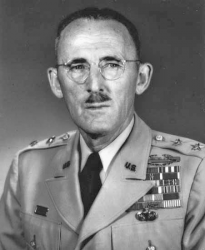
 |
|
|
||
|
Charles Draper William Canham |
||||
|
Graduate, U.S. Military Academy, Class of 1926 Engagements: • World War II (1941 - 1945) |
||||
| Biography: | ||||
|
Charles Draper William Canham Charles Draper William Canham was born on 26 January 1901 in Mississippi. He joined the Army on 23 May 1919. In 1921, as a Sergeant, Canham took a course in the Army's first Preparatory School to allow soldiers from the ranks to attend the U.S. Military Academy. He was chosen to attend and graduated from West Point in 1926. Prior to World War II, he served in the Philippines and Shanghai and was one of the purchasers of the Shanghai Bowl. During these years he acquired a reputation as a strict disciplinarian and superb leader of troops. As a Colonel, in 1942 he took command of the 116th Infantry Regiment shortly before it sailed for England. Canham's 116th Infantry, alongside the 1st Infantry Division's 16th Infantry Regiment, was chosen as the first to land at Omaha Beach on D-Day. The opening scene of the movie 'Saving Private Ryan' depicts the conditions under which Canham's Regiment landed on the Dog Green Sector of Omaha Beach along with one company of Army Rangers. Shortly after hitting the beach, Canham was shot through the wrist; refusing evacuation, he moved his men off Omaha Beach and inland. Sergeant Bob Slaughter (D Company, 116th) remembers Canham screaming at soldiers to move off the beach and go kill Germans. Slaughter remembers him yelling at one lieutenant hiding in a pillbox from a German mortar barrage, "Get your ass out of there and show some leadership!" Don McCarthy (Headquarters Company, 116th) remembers seeing Canham walking upright along the beach in the face of enemy fire, "I got the hell out of there and moved forward. I was more afraid of Colonel Canham than I was of the Germans." For his actions on Omaha Beach, and in the fighting to take Saint Lô, he received the U.S. Army's second highest award for valor in combat, the Distinguished Service Cross. Soon afterwards Canham was promoted to Brigadier General and was named as the Assistant Division Commander of the 8th Infantry Division. It was in this capacity during the surrender of the German garrison at the Port of Brest that Canham unknowingly gave the 8th Infantry Division its motto. Upon entering the headquarters of Generalleutnant (Lieutenant General) Hermann-Bernhard Ramcke, a famed leader of German paratroops, Ramcke demanded to know the lower ranking Canham's credentials as a condition of surrender. Unruffled, Canham pointed to the dirty and tired American soldiers he had brought with him to witness the surrender and said, "These are my credentials." The account of this event, which was reported in the New York Times, saw in this spontaneous statement of a combat leader the greatest tribute ever paid to the real power of the American Army, the individual soldier. By the end of World War II, Canham had earned every award for valor, except the Medal of Honor, from the U.S. Army. He was also awarded the Distinguished Service Order by General Bernard L. Montgomery of the British Army and several awards for valor from France. After the war, Canham was Assistant Division Commander of the 82nd Airborne Division and later became Commanding General of the 82nd. He was also the Commanding General of the 3rd Infantry Division and the Commanding General of XI Corps. Major General Canham retired from the Army in 1960 with 41 years of service. Medals, Awards and Badges Distinguished Service Cross He was also awarded the Distinguished Service Order (Great Britain). Distinguished Service Cross Citation The President of the United States takes pleasure in presenting the Distinguished Service Cross to Charles Draper William Canham, Colonel (Infantry), U.S. Army, for extraordinary heroism in connection with military operations against an armed enemy while serving as Commanding Officer, 116th Infantry Regiment, 29th Infantry Division, in action against enemy forces on 6 June 1944, at Normandy, France. Colonel Canham landed on the beach shortly after the assault wave of troops had landed. At the time, the enemy fire was at its heaviest and had completely arrested the attack. Though wounded shortly after landing, Colonel Canham, with utter disregard for his own safety, continued to expose himself to the enemy fire in his efforts to reorganize the men. His personal bravery and determination so inspired and heartened the men that they were able to break through the enemy positions. Colonel Canham's outstanding leadership, gallantry and zealous devotion to duty exemplify the highest traditions of the military forces of the United States and reflect great credit upon himself, the 29th Infantry Division, and the United States Army. Headquarters, First U.S. Army, General Orders No. 29 (June 29, 1944) Death and Burial He died on 21 August 1963 at Walter Reed General Hospital at age 62. He is buried at Arlington National Cemetery in Arlington, VA. |
||||
| Honoree ID: 2310 | Created by: MHOH | |||
Ribbons
Medals
Badges
Honoree Photos
 |  |  |
 |  |
 |


